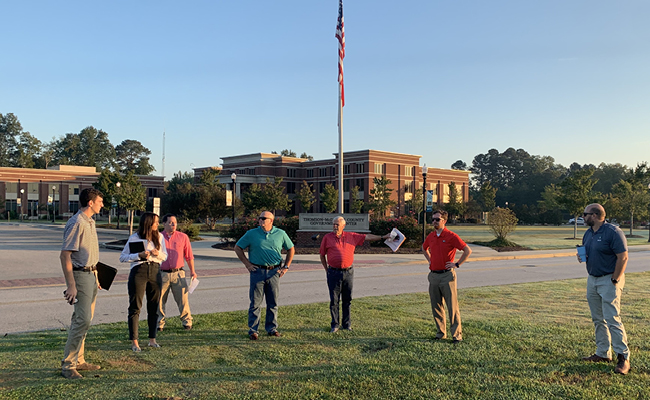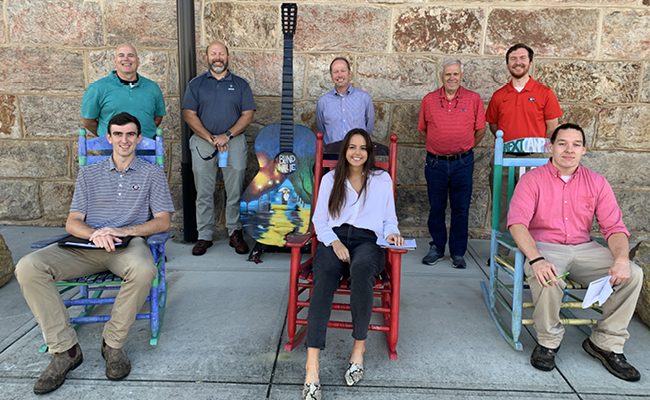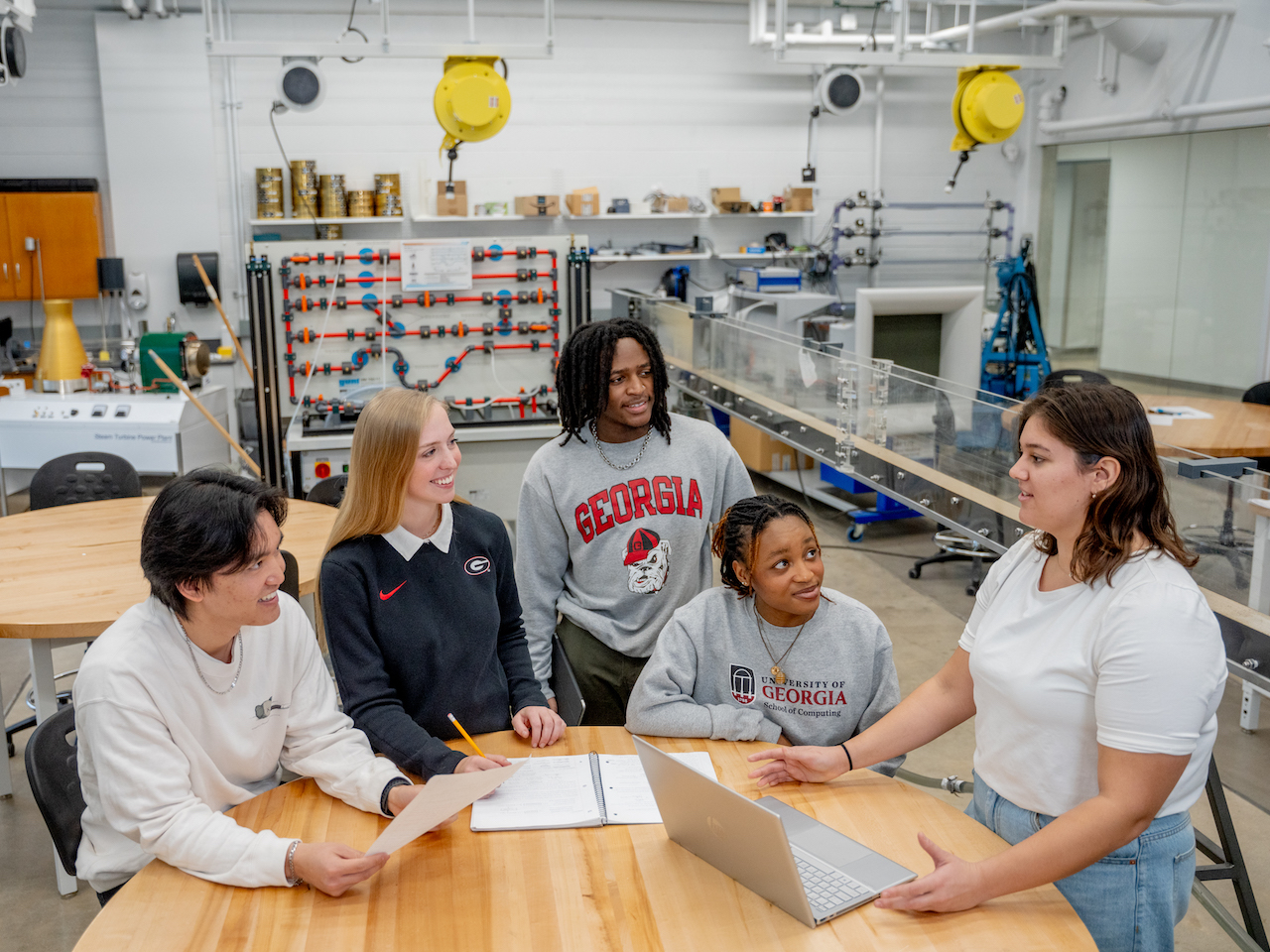 Once Stephan Durham starts talking about his students, it’s hard not to feel the pride and joy he takes in their accomplishments.
Once Stephan Durham starts talking about his students, it’s hard not to feel the pride and joy he takes in their accomplishments.
“From the professional and being prepared side of things, this is where our students shine when I talk to employers,” said Durham, the assistant dean for student success and outreach at the University of Georgia’s College of Engineering. “Our students come very well prepared, and our employers tell us they don’t feel afraid putting a University of Georgia graduate in front of a client because they know they’re ready for that. That’s always good to hear.”
They’re ready for the myriad of challenges that come with working in a professional environment because the College has sought to ensure its students are ready and able to contribute from day one by utilizing a Capstone Design program. Employed by countless colleges and schools across the country, the program provides students with an opportunity to get a real-world experience that meshes their academic studies with the rigors of a hands-on, technical project.
However, the UGA College of Engineering has structured its Capstone Design process to be an immersive and expansive program that goes beyond the ones used by many of its peers. It’s a comprehensive approach that best simulates what it will be like for students once they begin their professional careers.
“Most engineering programs now incorporate what we call a Capstone Design course, though that course can look very different depending on the university and the program,” said Durham. “At UGA, we have a year-long program that pairs students with external clients such as companies and communities and give them time to work through the engineering design process.
“The important note being the design process isn’t just the technical working calculations and putting together the engineered drawings or prototype, but it’s also meeting with a client, listening to the client and asking questions about their needs, constraints, and funding opportunities for the project.”
Students are matched up with projects and partners across the state with a few projects nationally, and preparation for the Capstone work is intentional and focused. All 450 participating students must complete a series of leadership modules conducted by the J.W. Fanning Institute for Leadership Development. These courses, known as the Emerging Engineers Leadership Development (EEDL), are structured to equip the students with the professional skills necessary to enter today’s engineering profession.
The sessions cover an array of topics, from managing conflict within the team to effectively communicating with project stakeholders. The first session, which was conducted during the opening week of classes for Fall semester, helped students identify their individual leadership styles.
Students also must complete a survey that evaluates strengths and weaknesses, as well as areas of interest for study, project preferences and more. Durham and other Capstone advisors and mentors use this information as they make assignments for the more than 100 Capstone project teams.

UGA College of Engineering students Charlie Voytek, Nikki Knox, and Houston Lynn (seated, left to right) developed an engineering design for a railroad-themed park in downtown Thomson as part of their Capstone Design project. Also pictured (back row, left to right: John Waller, Thomson-McDuffie City Administrator; David Crawley, Thomson-McDuffie County Manager; Kenneth Ursy, Thomson Mayor; and Sam Perren, UGA Archway Professional.
Connecting academics to real-world engineering challenges
One group of three students, Nikki Knox, Houston Lynn and Charlie Voytek, was tasked with preparing a site design that could guide the ideation and development of a public park in Thomson. A small community located 30 minutes from Augusta, its local leaders sought ideas for a new gathering space to anchor its revitalized downtown community and had a wish list of various features and elements that needed to be accommodated.
Thomson-McDuffie County is a UGA Archway Partnership community. The Archway Partnership, a unit of Public Service and Outreach, was created to enhance UGA’s land-grant mission of teaching, research, and service while addressing self-identified community issues across Georgia. Each year, dozens of UGA engineering students lend their expertise to Archway communities.
Following the process laid out in the College’s Capstone program, Knox, Lynn and Voytek participated in exploratory meetings with local leaders in Thomson to kick off work, conducted site visits to survey the property and did what Durham describes as “customer discovery” to better understand the views from various stakeholders.
The lessons learned from EEDL proved to be invaluable for the student team as they navigated this process.
“All of this was new to me because I’ve never worked with a client,” said Knox. “I’ve simulated doing so for class projects, but nothing like this. (In EEDL), you write about what you learned and how you could apply it to your Capstone project. It was really helpful.”
For instance, it was apparent the local community had a list of prioritized items, ranging from a splash pad water feature to an amphitheater, that needed to be taken into consideration for any design. However, a host of challenges including space limitations, access to utilities and cost put limits on what could feasibly be delivered in any plan.
As such, the students crafted a variety of options for local leaders to consider, ranging from one design that incorporated all the features and others that included some and nixed others. It was an opportunity for the group to demonstrate their expertise and take ownership of the design process.
“Comparatively with some class projects, we’re often given a lot more parameters,” said Voytek. “However, with our Capstone work we are the engineers and the designers coming to Thomson as the ’experts,’ as Dr. Durham would say. We’re expected to come up with the solutions.
“This isn’t a holding hands kind of thing, and you can as far or as deep into it as you want.”
The team said the entire experience has been very collaborative, with the partners in Thomson eagerly sharing their feedback and working closely with the students to overcome challenges and identify solutions.
“They’ve given us a lot of freedom in how we want to tackle things,” Lynn noted. “We’ve been very careful, so once we think we have something figured out, we’ll go back to them, show them what we’ve worked on and get their feedback on it.”
The community likely will use the plans and designs prepared by Knox, Lynn and Voytek to attract funding to ultimately build the park within the next few years, Durham said. Should that happen, it will be a testament to the work done by the students during their first foray into managing the design and planning of a project of significant size and scope.
But as Durham is quick to point out, the Capstone Design program is merely one step in the broader educational journey of the College’s students, one that doesn’t end with their time in Athens.
“Learning doesn’t stop when you graduate,” Durham said. “As an engineer there is no way to learn everything you need to know by the time of graduation. Your learning must continue, and a big part of Capstone is learning how to learn. It’s being able to say, ‘I don’t know how to do an erosion control plan, so you must read the manual and learn it and implement.’ Our students will learn they have to go seek answers and solutions.”
By Johnathan McGinty
The College of Engineering will host its annual Capstone Design Showcase on Thursday, April 28 at The Classic Center. At this event 108 Capstone Design projects including students across eight undergraduate engineering majors will be highlighted and present solutions in community impact, computerized systems and software, machine, manufactured system and process, medical devise and biological process, and sustainable design. A public viewing period is held from 2:30 – 4:30 p.m.


